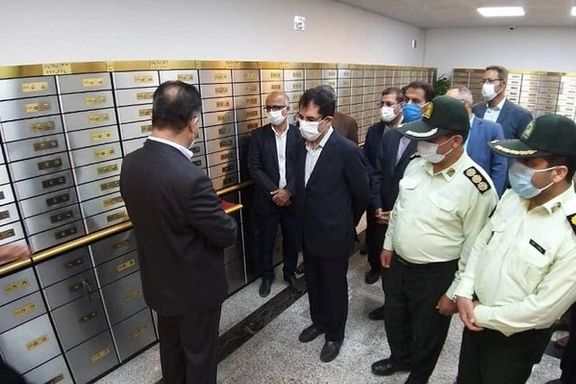Losses Unknown After Tehran Bank Robbers Pilfer Safety Boxes

State media has played down a bank heist that saw thieves break into at least 200 safety deposit boxes in a central Tehran branch of Iran’s largest bank.
Bank Melli (National Bank), which is state-owned, issued a statement Monday saying thieves had entered its branch near the University of Tehran and accessed fewer than 200 safety deposit boxes.
The bank is about half a mile from the headquarters and residence of Supreme Leaser Ali Khamenei.
Iran was in a four-day holiday from Thursday to Sunday marking the death anniversary of Ayatollah Ruhollah Khomeini, founder of the Islamic Republic. Apparently, the robbers gained access from an adjacent building during the holiday, and it is not clear how long they were inside.
Officials said an investigation was underway, with several bank employees “under observation” for possible “dereliction of duty.”
The gall of the robbers has fed social media speculation, and even comparisons with famous bank robberies elsewhere in the world, like the 1983 Brink’s Mat heist in the United Kingdom. Bank Melli denied social media reports that 1,000 boxes had been breached and referred simply to an “incident” in a press release.
Most state media avoided lengthy reports while also denying that as many as 1,000 boxes had been breached. State broadcaster IRIB put the number of safety deposit boxes opened at 250, while others used the phrase ‘damaged boxes.’
Inside job?
IRIB said that the thieves appeared to have been familiar with the bank’s interior and had stolen the main device recording footage from surveillance cameras. IRIB revealed that the bank’s alarm was not connected to the police and had only sent a text message to the branch manager, who ignored it as the system had been prone to false alerts.
The robbery is seen by some as an ‘inside job,’ and by others as another example of official ineptitude following the collapse of a high-rise building May 23 in Abadan, a refinery city in the oil-rich Khuzestan province, which killed at least 40 people and is widely seen as the result of officials ignoring warnings from engineers in allowing the owner to add five more floors. The disaster led to anti-government protests in the province and elsewhere.
As 80 percent of the economy is controlled by the government, including the banking sector, ordinary people often see such incidents as the result of inefficiency, personal and political nepotism and in some instances corruption.
Media and officials in Tehran say it is not clear what the bank robbers stole from the safety deposit boxes, since banks have no information about what people put in these boxes, which are used to safely store personal mementoes, precious foreign currency, and gold coins bought as a hedge against inflation.
It is also not clear if there is any kind of insurance covering losses sustained by customers. One report last year suggested Iranians were keeping $25-$30 billion in cash “at home,” which would include money in bank deposit boxes.